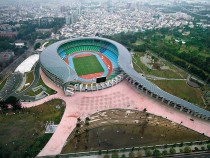
© Fu Tsu Construction Co. Ltd.
In 2009, the World Games were held in Kaohsiung in Taiwan. The architectural competition for the main stadium was won by Toyo Ito with a flowing, dynamic design that has been compared to the form of a dragon. Situated at the lower, tail end are the ticket counters and restaurants. From there, the roof rises continuously, hugging the oval of the playing field and reaching its highest point in the main stand at the southern end – the dragon’s head. Adjoining this is the open entrance area, which merges with a park at ground level. The actual sports arena lies roughly seven metres lower protected from the wind. The stadium structure consists of organically shaped reinforced concrete ribs, to which 159 steel trussed girders of various forms are fixed. These bear the permanent load of the 22,000 m2 roof area and conduct it to the two-storey concrete plinth. The primary structure is enclosed in a tubular-steel spiralling latticework. The more than 8,800 shimmering blue solar panels bear a certain resemblance to the skin of a reptile. Assembling these 2.5 to 3.5-metre-wide two-dimensional elements on the organically shaped roof posed a constructional challenge. The intermediate spaces that were inevitably formed were bridged by gasket seals to create a uniform surface appearance. The angle at which each solar panel is set is the outcome of a demanding calculation process. Optimally aligned to the angle of the sun, the panels generate 1.1 MWh of electricity a year – 75 per cent of the stadium’s energy needs.





